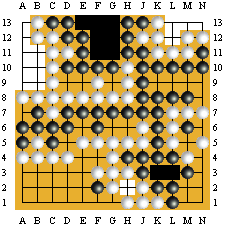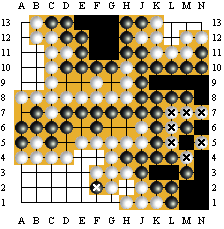|
Oyuna geri dön
GoGo, also known as Weiqi, is one of the oldest games in the world. It originated in ancient China between 2000 BC and 200 BC. It is played on a 19x19 board with two sets of stones - black and white.Start position and game object The game starts with an empty board where the intersections will be used to place stones: 
The goal of the game is to control larger territory of intersections than the opponent. Actually, the winner is determined by counting points of both players and the final number of points depends on several criteria (will be described below). How to make moves Black player starts the game and places one stone to an empty intersection. White player follows by placing one stone to another empty intersection etc. There are several rules to apply:
How to finish the game After both players decide they don't want to place any other stones and pass their moves, the game ends and the territories are highlighted. The next picture displays an example of finished game (13x13 board): 
In order to count the final score, it is necessary to mark dead stones. A stone (or a stone group) is called a dead group if it cannot be saved from capturing by the opponent. Otherwise, if a group can never be captured, it is called live group. The next picture shows a live black group (left) and a dead white group (right): 
The left group cannot be captured because it contains two eyes (an empty intersection with no liberties) and it is not possible to fill both of them without breaking the rules. The right group is dead because the black player can capture the group by filling the space with black stones, no matter if the white player adds more white stones to the group or not. The player who continues after two passes were made, can click on any stone (white or black) to mark it dead. Such stone will be highlighted by a cross to separate it from live stones. In order to make this process faster and easier, if a stone is marked dead, all other stones of the same colour in the same area surrounded by the opponent are marked dead as well. The following picture shows a position after marking 1 black dead stone and 7 white dead stones: 
In real games, the dead stones are removed from the board by players. BrainKing only marks the stones and leaves them on the board because it is more convenient for a turn based play. After one player finishes marking dead stones and submits the move, the opponent is shown the final position with the final score and asked to accept it or reject. If accepts, the game finishes and the player with a higher score wins. Otherwise the game is not ended and players can continue placing more stones or marking another sets of dead stones after passing. How to count the final score This is the formula to compute the final score for each player:
Since the black player starts the game, he has a significant advantage. In order to balance it, a value called komi is subtracted from the black player score. It is 5.5 for a 19x19 board, 4.5 for a 13x13 board and 3.5 for a 9x9 board. Let's show the previous picture again: 
Black player controls 7 spaces at the top and 22 spaces at the right side of the board (a territory is hidden below opponent's dead stones as well), that makes 29 total points of territory. 3 black stones are captured and 1 is dead, which leads to 25 points left. But the black player must subtract the komi which is 4.5 for a 13x13 board - the final score is 20.5 points. White player controls 8 spaces at the top left, 4 spaces at the top right and 21 spaces at the bottom side of the board, it makes 33 total points of territory. 2 white stones are captured and 7 are dead. White's final score is 24 points. White is the winner of this sample game. Handicaps If a strong player plays a game with a weak opponent, it is possible to make this game more interesting and balanced by setting a handicap. It means that the game is defined with a number of extra black stones which would be placed to the board at the first move of the black (weaker) player. After the handicap stones are placed and submitted, the game continues normally, placing one stone per move. All handicaped games are automatically unrated. Bu oyunu oyna Bunu da görün: Go, Go 9x9, Go 13x13 |
Tarih ve Saat
Online Arkadaşlarım
Favori Komiteler
Arkadaş Grupları
Günün ipucu
|
|
||||||||||||||||||||||||||||||||||||||||||||||||||||||||||||||||||||||||||
Copyright © 2002 - 2024 Filip Rachunek, tüm hakları saklıdır. Başa Dön |

























